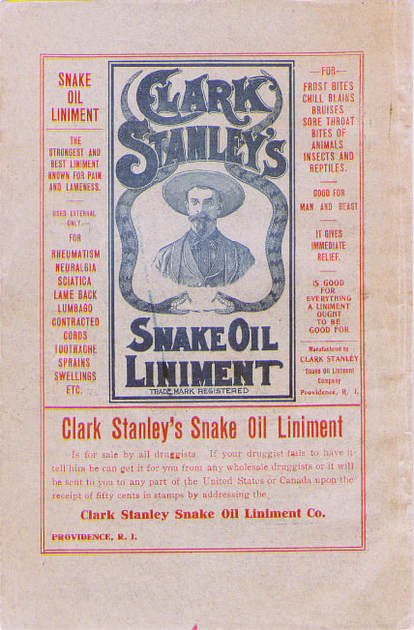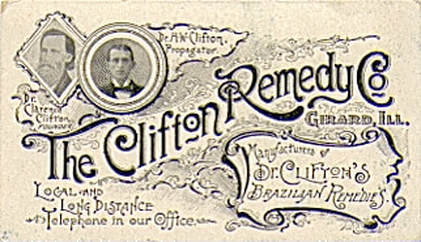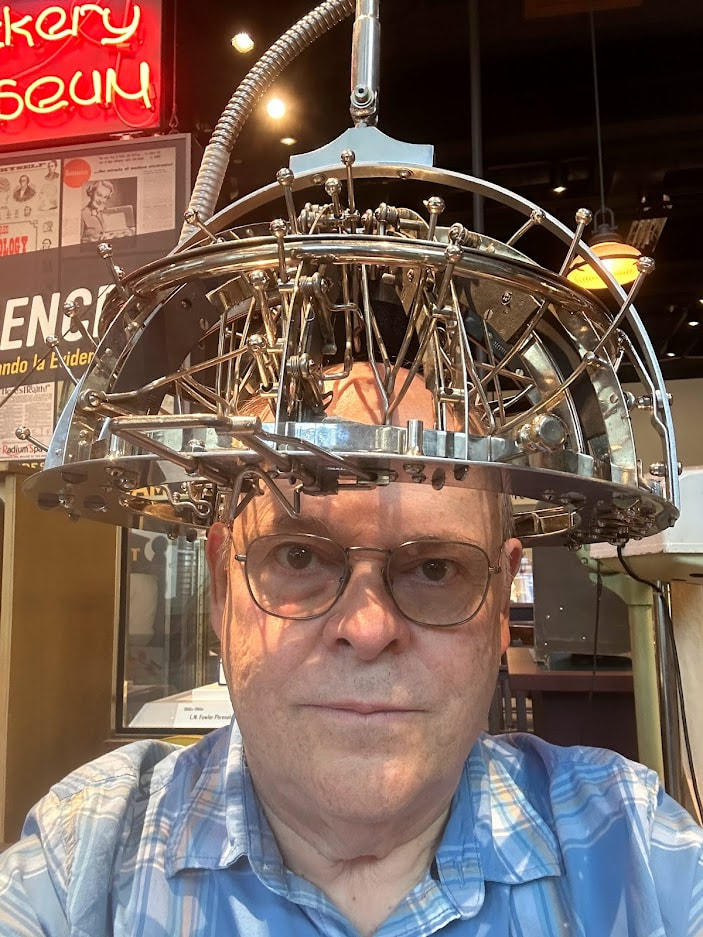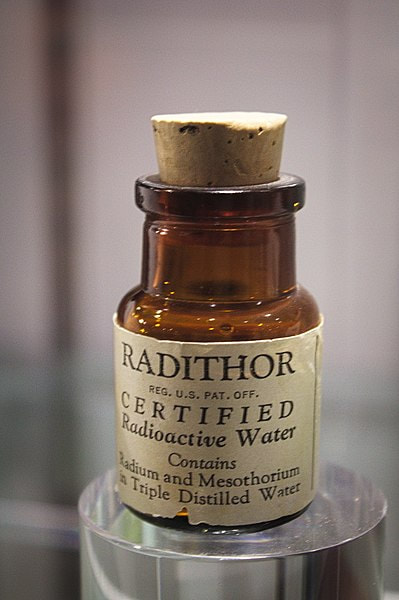|
Many people decry science-based government regulation of medical products, cures, or devices as an intrusion on the freedom of the people to make up their own minds on the effectiveness of such things. In this age of heightened skepticism of government and scientists, this question is once again relevant. Why should government and scientists be the ultimate arbiters of what you can sell to people or what products they can buy and use? Why not leave it up to the consumers themselves? With this question in mind, I visited the Museum of Quackery and Medical Frauds. This museum is located within the Science Museum of Minesota as an exhibit called “Weighing the Evidence”. The exhibit contains many bogus therapies and medical devices. In this essay, I will mention some. An interesting pseudoscience featured in the museum is Phrenology. Phrenologists stated that distinct areas of the brain were responsible for an individual’s cognitive functions, and then they claimed that by measuring the shape of a person’s skull they could gain insight into the extent to which these brain areas underlying the skull determined a person’s behavior and cognitive abilities. The central assumption of phrenology was that any area having a dominant effect in the personality would result in the skull over that area exhibiting a bump, which they would measure. Phrenology has been debunked by scientists. The phrenology areas of the brain do not correlate to brain function, and the bumps in a person’s skull do not correlate to brain shape. Regardless, phrenology was very popular from the mid-1800s and into the first third of the 20th century, and was used for things such as defending and treating criminals, evaluating a parent’s love for a child, and matching people for marriage. Whereas most phenologist relied on palpation, measuring tapes, or calipers to assess the “bumpiness” of the skull, others used more sophisticated equipment such as the psychograph. The museum has one such device invented and patented by businessman Henry C. Lavery which could measure a person’s skull and rate 32 different mental faculties from deficient to very superior. Needless to say, this is all bunk. One picturesque character featured in the museum is Dr. John Harvey Kellogg. Kellogg was a bona fide surgeon and is most known as the inventor of the corn flake. Kellogg was also the staff physician of one of the most popular medical spas of the early 20th century, Battle creek Sanitarium. At this site he subjected his patients to all sorts of therapies that have not been validated by science such as electrotherapy, hydrotherapy, mechanotherapy, phototherapy, thermotherapy, and others. Kellogg was also a great believer in using vibrations because, according to him, they improved health and relieved constipation. To this end, he invented a vibratory chair that vibrated 60 times per second and of which a working model is featured in the museum. Again, there is no evidence that this therapy works. There are many other bogus products and therapies featured in the museum ranging from tonics, magnets, and vibratory belts, to radio waves and lights of different colors. You may chuckle at some of the crazy claims, therapies, and devices featured in the museum, but it can be argued that at most they made people waste their money, and if the people liked them, that’s their business. The problem is that some therapies actually killed patients, and at the beginning of the 20th century the US government had limited authority to protect consumers. For example, before the deleterious effects of the radioactive element radium became widely known, it began to be marketed as an all-natural enhancer of health that would restore vigor, improve sex life, and cure many diseases. Radium was included in a wide array of products ranging from chocolates and suppositories to toothpaste and dressings. This led to many people suffering from radiation poisoning and cancer. One famous case was the radium girls. These were women working at factories painting the dials of watches with radium-laced paint, which they were told was harmless. As part of their work, the women would often lick their paintbrushes to sharpen them, a practice that was encouraged by their supervisors. These women developed several illnesses including widespread damage to their mandibles; a condition that became known as radium jaw. The radium girls, as they were then called, sued their employers, and the resulting trial and associated publicity led to the passing of labor safety and work compensation laws as well as the creation of the Occupational Safety and Health Administration (OSHA). Another famous case involved radium-laced water of which one particular brand was Radithor. The American industrialist and amateur golf champion Eben Byers was prescribed Radithor for an arm injury in 1927. He became a big fan of the stuff and over three years consumed 1400 bottles. Byers began losing his teeth and developed cancer in his mouth. His upper jaw and most of his lower jaw had to be removed leaving him severely disfigured, but his bones continued deteriorating and holes formed in his skull. He died in 1932 and was buried in a lead-lined coffin. His remains were exhumed in 1965 and were found to be dangerously radioactive. It has been calculated that Byers consumed more than three times the lethal dose of radium. Due to his high social profile, Byers became the poster boy for the ill-effects of radium, and its use declined thereafter. The final case that led to strong regulation of health products and therapies were the 1937 deaths of more than 100 persons, many of them children, as a result of the ingestion of Elixir of Sulfanilamide which contained the poisonous solvent diethylene glycol. Next year congress passed the Federal Food, Drug and Cosmetic Act, and as a result of this a proof of safety would be required before the release of any new drug or cosmetics. Going back to the question posed at the beginning of this post, history indicates that the average person is no match against bogus drugs or therapies cloaked in pseudoscientific mumbo jumbo backed by clever marketing campaigns. We need scientists to evaluate these things, ask questions about their safety and effectiveness, and conduct tests. We also need government to enforce the conclusions of the evaluation by the scientists. Additionally, many compounds or therapies may be safe but not effective or untested, and people want them to be labelled as such to prevent them from wasting their money. This is the function of science-based government regulation. The photo of the bottle of Radithor by Sam LaRussa is used here under a Creative Commons Attribution-ShareAlike 2.0 Generic (CC BY-SA 2.0) license. The other photographs belong to the author and cannot be used without permission.
0 Comments
 In a past post, I wrote about how it is not in the nature of science to analyze or comprehend God or any claim to theistic (related to God) intervention. I subscribe to the notion championed by the late Harvard paleontologist, Stephen Jay Gould, who argued that science and religion work within two different areas of expertise that he labelled “non-overlapping magisterial”. However, sometimes it is difficult for society to agree on where the boundaries of these areas are and whether one discipline is intruding into another. One such problematic situation is faith healing. Faith healing is the notion that people with a disease or injuries can be healed by appealing to a deity. While it is possible that incorporating the patient’s religious beliefs into the process of the medical treatment may lead to a better outcome, the most extreme forms of faith healing claim that the medical component is not necessary for a cure. This modality of faith healing normally involves a person such as a televangelist who carries out the alleged healing act, or groups of people such as parents of a diseased child that pray for healing to occur. From a mechanistic point of view, whether faith healing works should be easy to determine. You just compare the claims to the results. However, faith healers are unwilling to have their claims openly investigated. The few people who have investigated the claims of faith healers have found that the claims for spectacular cures were either false, exaggerated, based on faulty diagnoses, or involved diseases prone to be affected strongly by the patient’s psychology. However, if the healing does not work, it can always be asserted that the faith of the person being healed, or that of the healer’s, was not strong enough, that God will refuse to be tested, that the failure of the healing was part of the divine plan, or any other ad hoc explanation with a religious component. This is why science, in principle, cannot test these claims: it cannot be stated a priori in a manner in which everyone agrees what will constitute success or failure of the claim when put to test. This ambiguity contributes to shielding faith healing from scrutiny, and if you couple this to the fact that politicians, especially those representing conservative districts, are loath to deal with this issue, you can see why the faith healing universe is a breeding ground for liars and cheats. Consider televangelist Peter Popoff. He rose to prominence in the 1980s as a faith healer. People would flock to his sermons and he would reveal to them specific information about where they lived and what illnesses they had despite never having talked with them before. He claimed that he received this information from God, and he also claimed to be able to “heal” people of their ailments. In 1986 the magician and debunker extraordinaire, James Randi, figured out that Popoff’s wife, not God, relayed this information to Popoff by electronic transmission to an earpiece he was wearing. The way this worked was that his wife would gather the information from the crowd assembled outside, and during the sermons she would tell Popoff the names, addresses, and ailments of people that then he would proceed to call out and “heal”. After being exposed as a fraud, Popoff was forced to declare bankruptcy. You would have imagined that his career as a faith healer would be over, but not so. He has made a comeback, and he is once again raking millions of dollars from people that believe in him as shown in the video below. Popoff was perhaps the easiest faith healing scammer to expose because he made himself vulnerable by using forms of deceit that could be convincingly uncovered. Unlike Popoff, however, most faith healers are careful to employ more subtle tricks that leave a lot of wiggle room for ambiguity, and they are therefore much harder to pin down. The most disturbing aspect of faith healing involves children. After all, if adult people choose to send their money to a healer or to forsake valid medical treatment for an ailment, that is their choice. But you would think that a child is another matter. As it turns out there are many cases in the U.S. where children have died because their parents did not provide them with valid medical treatments choosing instead to subject them to religious rituals. In some states, parents whose children have died as a result of these practices have been convicted of manslaughter. However, in other states there are laws that shield parents if their children die as a result of having forgone medical treatment in favor of faith-based healing alternatives. The distressing thing about these cases is that they often involve diseases that are readily treatable by modern medicine, and the afflicted children die slow painful deaths. One of the factors muddying the waters in any discussion of the effectiveness of faith healing is that most human maladies are either self-resolving or have strong psychological components. This means that in a certain amount of cases faith healing will appear to work or at least do so temporarily, and this will reinforce its perceived effectiveness among the ranks of the believers. However, when faith healing doesn’t work (which is the case in most serious diseases), one cruel by product is that the patient or their loved ones tend to blame themselves for the failures (e.g. not having strong enough faith) thus adding another level of suffering to an already dire situation. For some people, the specter of government stepping in and thwarting religious freedom and the right of parents to decide what is best for their children trumps any possible arguments against faith healers. For others, witnessing the spectacle of thousands of people being milked of their hard-earned cash or dying as a result of not choosing medical treatment for their diseases makes them cry out for justice. I believe that we must decide as a society once and for all how to assess these practices. In my opinion, establishing scientifically whether faith healing works or not is irrelevant. The issue should be viewed from a consumer point of view. If faith healers or religious leaders advertise to their followers the notion that they should forgo medical treatment for potentially life-threatening but treatable diseases in favor of faith-based approaches, then they should be held accountable for the dependability of the product they are promoting and made responsible for the outcome. Image by Russell Lee is from the National Archives and Records Administration, and its use is unrestricted. In this post I present a step by step procedure that can be used nowadays to sell snake oil (i.e. a bogus product).  Step 1: First and foremost you need a product. This can be something tangible like a chemical substance, a procedure, or a therapy of dubious value, or even an unqualified candidate for public office. However it can also be something intangible like a fringe belief or ideology, or a questionable social engineering initiative. Step 2: Regardless of whether you know for sure your product is a fraud, try to transcend this knowledge and convince yourself of the opposite. The human mind has a near bottomless capacity to fool itself: make use of that! Create excuses for the shortcomings of your product, rationalize failures, move the goalposts, concentrate on any real or perceived positives and blow them out of proportion. Force yourself to believe in your product. When people look into your eyes they need to see honesty, certainty, passion, and trustworthiness. Those who master this step can actually become convinced that they are not selling snake oil at all! Step 3: In the old days once you had a product you would proceed to identify the target audience. Although this is still a valid step, a more effective approach is to first identify those entities that have the power to expose your product to be a sham and even prohibit you from implementing or selling it. Examples of some such entities can be the scientific establishment, regulatory government entities like the FDA, the news media, fact checkers, consumer watchdog groups, etc. Step 4: Proceed to identify your target audience. This step has often been difficult, but having performed step 3 first, this is now more straightforward. All you have to do is find the people that view with suspicion or contempt those entities that can be a danger to your product. The process of finding these individuals is made easier nowadays by the internet. You can gain access to webpages and blogs from many groups and individuals who are engaged in attacking their favorite boogeyman. Among these groups and individuals identify those that would be the most likely users of your product. Most snake oil salespersons find their target audiences in the social extremes such as the uneducated, or those with an education who think they know more than the experts. Befriend key segments of your target audience. Join their groups, go to their events, attend their churches, take up their causes, create goodwill, and while doing this never forget that tried and true ageless trick: tell them what they want to hear. Step 5: Having identified the entities that will seek to reveal the truth about your product, and having identified and infiltrated the community of individuals who loathe them, you now have to create a nefarious intent or conspiracy theory. This is important because your product will be attacked with evidence and facts. You need to be able to disavow these attacks by claiming that the entities attacking your product have some ulterior motive divorced from the truth. These conspiracy theories normally include a version of the “powers-that-be-screwing-the-little-guy” approach. For example, scientists aligned with pharmaceutical companies to discredit cheaper alternative therapies, the liberal or conservative media in conspiracy with political elites to spread fake news and maintain the status quo, right-wing groups affiliated with corporate interests to oppress working class people, left-wing groups affiliated with environmental extremist to limit people’s rights, etc. Step 6: Begin promoting your product to your target audience. Hire a lawyer to make sure you are following the laws, but identify and exploit the grey areas and loopholes in the regulations. Be vague! Try to avoid specific statements that can be used to pin you down, but when possible present opinions as facts, misinform, exaggerate, use innuendo, half-truths, out of context citations, and pick and choose studies or testimonials that support your product. Ask people to keep an "open mind". Talk the talk and create a believable impression that your are also walking the walk. Use social media and conventional methods to promote your product. However, don’t overdo it! Don’t say or write something that will make you toxic to wider audiences. When in doubt bite your tongue. Learn the ways of the weasel.  Step 7: When the attacks against your product begin, unleash the conspiracy theory within your target audience along with a barrage of attacks against your critics labelling them dishonest, corrupt, enemies of the people, and other useful epithets. Claim that you are being unfairly targeted and persecuted, and seek the help of your target audience. Invoke the right of the people to make up their minds unhindered by interference from government and other entities. Invoke community standards. Invoke states’ rights. Invoke in general any principle valued by your target audience that will give you an edge in the struggle. Link the viability of your product in some way, no matter how convoluted, to the survival of the way of life, values, and families of your target audience. Exploit the slippery slope principle (i.e. if your product goes, they are next). Appeal to their most alarmist basic instincts. Manipulate their emotions, stoke their fears, stir their passions, and whip them up into frenzy. The key thing to understand is that what you are trying to achieve is to create a sense of identity of your target audience with your product. The beauty of this approach is that, if you achieve this, truth and facts will become irrelevant! Any attack on your product will be seen by your target audience as a personal attack on themselves. If you make your product part of their identity, asking them to accept the possibility that your product is bogus is akin to asking them to commit suicide. They won’t even consider it. The best location to place the chains to bind people are not the wrists but the mind. Step 8: Widen your reach. Ask celebrities admired by your target audience to endorse your product. If applicable, contract an “independent organization” (nudge-nudge, wink-wink) to test your product and then broadcast the undoubtedly positive results. Team up with other like-minded snake oil salespersons to support each other. Hobnob and network with the power brokers supported by your target audience. Unless you are already selling a political candidate, it is very useful to link your product to politics. Remember that politics often is about winning, not about the truth. If elected representatives perceive that they will get more votes if they support your struggle, then you may have allies. Ask your target audience to write to their congressmen and to go to town hall meetings to bring up the issue of the attacks against your product. Donate to political campaigns. Even more effective than politics is to associate your product with religion. This may be more or less difficult to do depending on the nature of your product, but if you can accomplish it, it’s a Godsend! Step 9: Along the way don’t forget to save for a rainy day, preferably in bank accounts or assets that cannot be seized by the government. Avoid a lifestyle of excess luxury (there will be time for that later), and cultivate an image of modesty and genuine interest in the “good” of the people. Ride your product through all of its business cycle and either go on to sell other products, or cash in and reap your rewards. Step 0: This is the most difficult, but also the most important and vital step of the whole sequence, and one which should be carried out before you perform any of the above steps. This step involves asking yourself if you really want to manipulate people and smear the truth. Selling snake oil is not a victimless activity. In one way or another you will be damaging the lives of countless individuals and communities. Do you really want to exploit people and trample common decency and basic human values for a chance to gain riches, prestige, and power? If the answer is yes, proceed to step 1. The figures are in the public domain. National Library of Medicine, Varieties of Medical Ephemera, Medical Show. |
Details
Categories
All
Archives
June 2024
|


 RSS Feed
RSS Feed